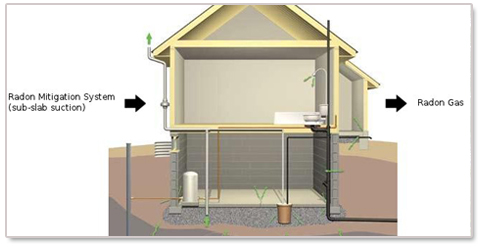
If you are buying a house in NJ, one of the tests that should be performed is a radon test. It is an easy test, typically performed by your general home inspector and high levels can be mitigated. Homeowners can also test for radon themselves or hire a NJ certified radon measurement company to perform the testing. A list of certified measurement companies is available at www.njradon.org. The Surgeon General recommends that all homes below the third floor be tested for radon.
What is Radon?
Radon is a radioactive gas that comes from the breakdown of naturally occurring uranium in soil and rock. It is invisible, odorless and tasteless, and can only be detected by specialized tests. Radon enters homes through openings that are in contact with the ground, such as cracks in the foundation, small openings around pipes, and sump pits.
Why is Radon a Concern?
Radon undergoes radioactive decay that forms decay products. Radon and its decay products release radioactive energy that can damage lung tissue in a way that causes the beginning of lung cancer. The more radon you are exposed to, and the longer the exposure, the greater the risk of eventually developing lung cancer. Radon is the second leading cause of lung cancer in the United States, resulting in 15,000 to 22,000 deaths per year.
How Do You Test for Radon?
Typically a buyer’s home inspector will perform the test as part of their general home inspection. He or she places a test kit in the lowest livable level of the home in an area where the test kit will not be disturbed and leaves it there for 2-7 days. After that time, he or she picks up the test kit and sends it to a laboratory. The laboratory analyses the test and provides the test report with the radon reading after about 2-3 days.
How Do You Interpret the Results of the Radon Test?
The DEP and the EPA both recommend that action is taken to mitigate the home if test results indicate radon levels of 4.0 picoCuries per liter (pCi/L). About 1 in 15 U.S. homes is estimated to have radon levels at or above this EPA action level. The average outdoor level in the U.S. is 0.4 pCi/L and the average indoor level is 1.3 pCi/L. There is no truly “safe” level of radon since lung cancer can result from very low exposures to radon, however, the risk decreases as the radon concentration decreases.
How Do You Mitigate Radon?
The most common type of radon mitigation system is the sub-slab depressurization system. A pipe is installed that runs from below the basement flooring to above the roofline, with a fan at the top that draws radon out from under the slab. Cracks and openings in the foundation are sealed. The radon is vented through the pipe to the outside, where it is quickly diluted. The average price of such a system is around $1200 but can vary depending on the characteristics of the home and the underlying soil.
How Do You Know The Radon Has Been Mitigated?
After the home has been mitigated, the mitigator should perform a post-mitigation test to prove the system is working properly. Retesting your home every two years will tell you whether or not your system is still working effectively in reducing the radon level to below 4 pCi/L.
For more information go to the EPA’s Home Buyer’s and Seller’s guide to radon: http://www2.epa.gov/sites/production/files/2015-05/documents/hmbuygud.pdf or www.urbansuburb.com